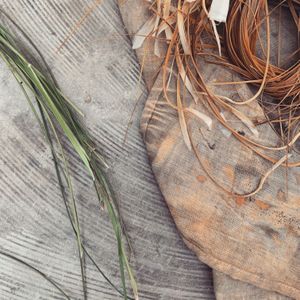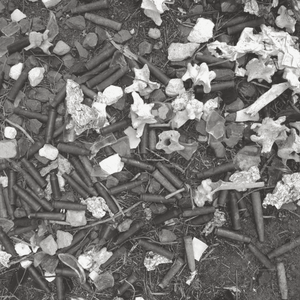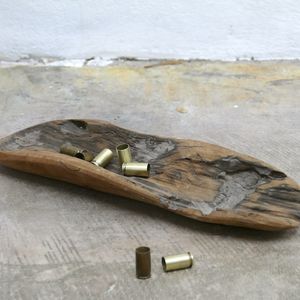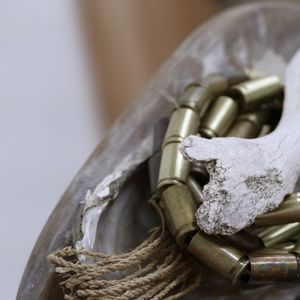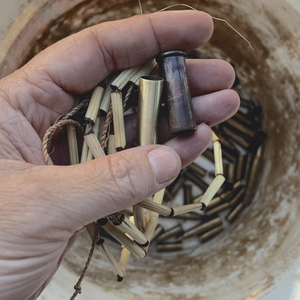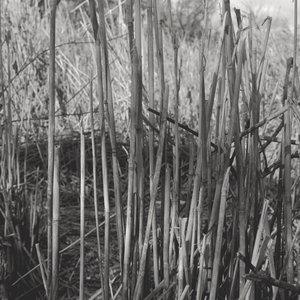Lucy Simpson
/https://adc-2-prod.s3.amazonaws.com/media/dd/images/hands.bbb693a.jpg)
Isolate Make: Creative Resilience in a Pandemic explores how creative practice has adapted to isolation, associated restrictions and production challenges, or in response to the year’s tragic global events. Through images, text, video and final work on exhibition Isolate Make gives a unique insight into a wide range of contemporary art, craft and design practice.
This work was created as a means by which to map and mark time, to process experience and pass on story. Its form is inspired by the traditional reed necklaces made by people of the river, drawing connections between my saltwater Sydney home in Gadigal country (where the fibre was collected and twined), and the floodplains of our ngurrambaa in north-western NSW, the Yuwaalaraay lands to which I belong. It references the making of living narratives and their importance; wearable manifestations of place, relationships and memory, knowledge and lessons transferred from mother to daughter. It comments on our responsibility to country, and to each other - and the fundamental importance of balance.
In this work I have documented a period of heightened violence and unrest, crisis, sickness and trauma of both people and place - with the aim of transforming pain to healing through the vehicle of making and remembrance. Lucy Simpson
IN CONVERSATION:
Who are you?
My name is Lucy Simpson, I’m a Yuwaalaraay woman and process led designer / maker.
Where do you work?
I have primarily worked from home over the past 11 years with my studio practice Gaawaa Miyay. During Isolation and lockdown however, I migrated to a shared studio space with my Husband Gerome (whakairo / wood carver) in the inner west of Sydney. A space for us to share, make and hold ground for our creative practices respectively and collectively.
Describe your practice?
My practice traverses a variety of disciplines / mediums / applications, and is drawn together by the common thread of story, place and exchange - with each narrative and memory informing the materiality and technique of the work depending on the vehicle for exchange or required outcome. Past projects have included; textile design (from screen printed and digital fabrics to bespoke rug design), soft furnishings for interiors, graphics and print media, fibre work and weaving, jewellery, sculpture, ceramics, object design, set and production design, spatial design and experiential / public art works, as well as collaborations in fashion and furniture.
How has the coronavirus pandemic affected your practice and your ability to make a living?
Working from home whilst also having a full house and two young daughters to support and care for through home schooling, was difficult, particularly as I had just begun development of a large-scale sculptural wire work for a then upcoming exhibition. This was in addition to the commencement of postgraduate studies and a number of ongoing commissions. We found however, through the use of the studio we were more able to balance the work / life / creative balance with the wellbeing of us all as a family at the centre. The separation from other family members and Yuwaalaraay ngurrambaa (homelands) was particularly difficult during this time especially, as the water had just returned to our freshwater rivers after a period of such severe drought. I was able to traverse this distance and sustain those feelings of longing through my creative practice and the ‘business of my hands’ - sustaining strength and instilling empowerment in moments of need.
What are you making?
During walks along the Cooks river with family I began to re-connect with the materiality of place in Gadigal country, sharing knowledge on plants and seasons, traditional use and making with my eldest daughter Hawaiiki. This became a time for us to connect through creative exchange - a way to map and mark time through experience and creation of objects and ‘wearable moments’. This gave us tangible memories to hold on to while we moved through an expanse of time unknown, moments of uncertainty, sickness and unrest - as it unfolded not only within our own lives and communities but across the globe.
What is the concept behind this work?
This work was created as a means by which to map and mark time, to process experience and pass on story. Its form is inspired by the traditional reed necklaces made by people of the river, drawing connections between my saltwater Sydney home in Gadigal country (where the fibre was collected and twined), and the floodplains of our ngurrambaa in north-western NSW, the Yuwaalaraay lands to which I belong. It references the making of living narratives and their importance; wearable manifestations of place, relationships and memory, knowledge and lessons transferred from mother to daughter. It comments on our responsibility to country, and to each other - and the fundamental importance of balance.
In this work I have documented a period of heightened violence and unrest, crisis, sickness and trauma of both people and place - with the aim of transforming pain to healing through the vehicle of making and remembrance.
Throughout its development my mind was cast to the ‘nest' or grounds of courtship of a bowerbird. A collection of objects at a specific time / season, and for this reason - materials gathered from immediate surroundings - a survey of place, experience and time.
I remember vividly one such particular site within the grounds of our ngurrambaa at Dharriwaa / Narran Lakes (the big meeting / camp / ceremonial grounds) in Yuwaalaraay country which had been meticulously crafted from bullets, bones and broken glass. At the time I was fascinated to catch a glimpse inside the mind of the little wiidhaa, the elusive spotted bowerbird, but my fascination soon turned to sorrow realising that the most beautiful things to collect were born of discard, violence and death. It turned my mind to my immediate surroundings and the materials that might best communicate the collection of experience and emotions spent in our months of isolation, sickness (human and environment), death and social unrest.
What is the process of making this work?
This work is inspired by traditional reed necklaces made by people of the river, it connects my saltwater Sydney home by the Cooks River in Gadigal country to our freshwater Yuwaalaraay lands in floodplain country. It references the reed necklaces we continue to make, with knowledge and lessons transferred from mother to daughter. It comments on our collective contemporary culture of waste and discard and remembers responsibility to country, and each other. The conscious decision to work with ‘once-fired bullet shells’ speaks of this discard and of violence, trauma and hate - transforming pain to healing through the vehicle of making, and speaks of the power held in continuing cultural practice.
Is this process the same or different to your usual process? If different, how has it changed?
Covid has seen my practice shift to a more sustainable conscious practice - mindful not to bring anything completely new to the world as I begin to better understand the roles I play as Yuwaalayaay mother / maker / caretaker
Has your thought process changed? If so, how, and has that affected your work?
From this point forward everything I do references the importance to act with intention - to actively contribute to a better world for my daughters and the coming generations.
What is the value of making art right now?
For me, making has been fundamental to my wellbeing. It has helped me understand and process complex emotions and better understand the role I play and the responsibilities I hold in my communities (cultural and professional) - to both people and place.
How do you think your practice will change when we emerge from isolation?
If this time has taught me anything, on a very elemental level, I feel that there is much that needs to change for us to ensure our continuities. I have a new depth of understanding of the value of relationships, and I now see time in a very different way. For me, one day has finally become today.
ABOUT LUCY SIMPSON
"Design is a tool, making a process, and art the narrative that connects us back to story and experience. Through my work I create, tell stories and interpret in ways that can often transcend words and language, flowing from deep within my bones. Winangaylana ngay mara, my hands remember (their making continues)".
Yuwaalaraay woman Lucy Simpson, founder of Gaawaa Miyay (2009), is a process led trans-disciplinary designer / artist / maker who works across a range of mediums including graphics, textiles, object and spatial design (from interiors to public installation). Gaawaa Miyay (river daughter) is her creative studio practice. She has exhibited, created, collaborated and consulted on an array of projects and conceptual works over the past decade which speak of country, memory, time, experience, and notions of exchange.
Image Top: Lucy Simpson, work in progress, 2020. Photo: courtesy of the artist

/https://adc-2-prod.s3.amazonaws.com/media/dd/images/hands.bbb693a.jpg)
